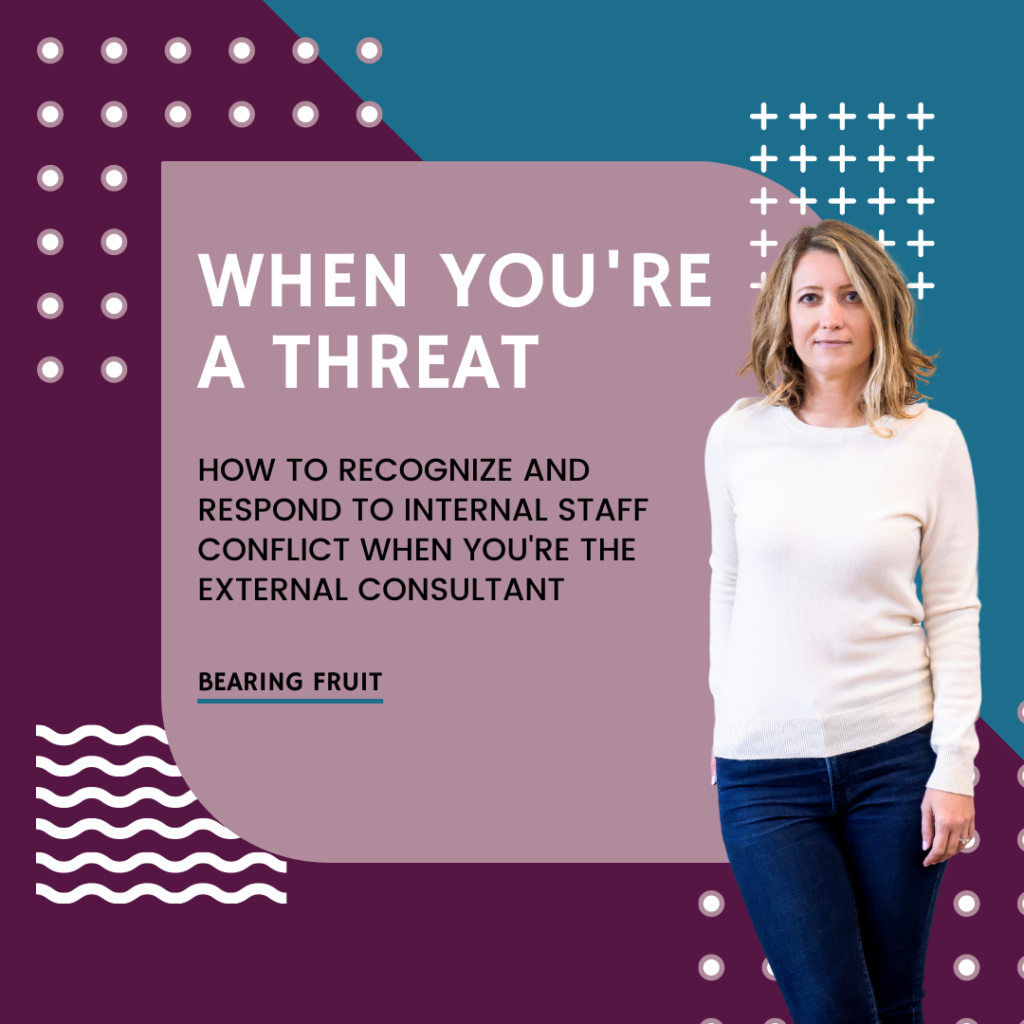Your First Hire
Hiring your first person is scary.
How will I bring in enough money to pay for them?
What if I have a lapse in contracts? How will I cover their salary?
What work would I give them? I like having my hands in all aspects of my projects.
Do I have to supervise? How does one actually manage?
What if they do something dumb and wreck my business?
It’s going to take me forever to train them and I don’t have that spare time.
What if I become reliant on them and they leave?
Then these worries link hands and dance in a circle in your brain and you push off hiring yet again.
At this point in my career, I’ve gone through seasons of hiring a bunch of staff and times when I scale back drastically.
Throughout, Komani Lundquist Cedano has been my go-to resource for growing and shrinking your team with ethics and heart. She’s a co-owner at Via Evaluation and has largely been responsible for Human Resources including hiring and managing staff. Like, the things that scare most of us about hiring and managing? That’s her full-time job.
Let’s pick her brain, shall we?
When to Hire
Stephanie: Most solo practitioners who eventually hire someone will say that they wish they’d done it sooner. So what kind of metrics should we be looking at to help us determine when to hire someone?
Komani: I suggest using an Eisenhower matrix. Draw a simple 4-cell table and fill it with the following:
1. what you’re good at
2. what you’re not good at
3. what you enjoy doing
4. what you don’t enjoy doing
Use this Eisenhower matrix to determine how much is in the ‘not good at’ or ‘don’t like’ – these items are the things to delegate.
Then, create an estimated employee budget (total estimated cost) of an employee to do the job you believe will best aid you in your growing business. Knowing this estimated total cost helps you set a baseline for the revenue you need to bring in to support them.
This cost should include expenses like their salary, benefits, and equipment, but also factor in the time spent managing them (instead of doing project work yourself) and related administrative costs. An old framework I heard about 15 years ago was $125k of revenue per employee. I suggest using a minimum revenue target of 2x their base salary or 1.5x their total estimated cost.
Then, determine a future revenue projection. You should know what you made in the past year, which can serve as your baseline, and then write up a list of what you currently have or expect to have in revenue for the coming year. This analysis will give you the information needed to determine if your revenue will cover both you and your new staff member.
Also, make sure you’ve exhausted outsourcing your other resources, such as your professional bench of an accountant or bookkeeper, lawyer, business coach, and financial advisor. Ensure you’ve maxed out the capacity of folks you’ve contracted to support your work.
Employee or Contractor?
Stephanie: I’ve only ever worked with contractors to fulfill the various roles in my company. When do you advise taking on employees versus working with a bench of contractors?
Komani: Taking on employees, versus contractors, should be a strategic, practical, or ethical decision.
Strategic: If you’re planning on having more than one employee (eventually). The return on investment is there to build the systems employees require. Or, based on your Eisenhower Matrix, you see that there’s a clear, full-time role you need to have someone else do.
Practical: You’re swamped and cannot complete work, or are already effectively using a single subcontractor nearly full-time. This is a clear indicator that they really should be an employee.
Depending on which US state you are in, you may be required to make this person a W-2 employee. This might also apply to having an intern that you realize you want to keep.
Ethical: You care about equity and see that employing folks and providing them access to a place to do work (an office), health insurance, paid time off, and other benefits is actually about equity. Not everyone can/is able/has access to be able to set up their own business/work from their house/pay for their own health insurance/manage the wild world of taxes/negotiate contracts.
Employers are required to provide many things for your employees, where contractors are really on their own. Second to this, it’s an ethical concern to ensure you can keep your promises to your clients – be reliable – even if an emergency arises.
When to Hire a People Manager
Stephanie: Say you’re one of those entrepreneurs that loves to do the actual work and, while you want assistance via contractors or employees, you don’t want your role to shift entirely to managing them. At what point do you need to hire someone to manage your employees? It seems like this type of hire would be a big step in organizational complexity.
Komani: Ultimately, knowing your own highest and best use (as a visionary? meeting with clients? writing reports?) is key. Recognize that you can choose what that is as you grow in your business. Your role in your organization will shift if you intend to bring employees in, and getting a manager will help, but won’t take away the burden.
When you make your first hires, seek folks who are great at taking high-level direction and can run with your ideas and plans. As your organization grows, you’ll find the need to bring in people with a greater variety of skill sets and increased specialization. You will need more guidance and structure for them, which is something a manager can help with.
Often, organizations get (or promote someone to) a middle-type manager after the first three employees. Someone who enjoys creating systems and processes and ensuring quality work products.
Three employees isn’t a hard and fast rule, but it’s often when I see small business owners struggling – keeping up with project oversight, business development, administration, and management of employees. This seems to be a challenge spot and time for a greater strategic move, which could be the hire of a manager.
It’s a big step in organizational complexity, and I suggest each entrepreneur know and be able to share what their organization’s overarching strategy (short and long term goals) and values are to help guide a manager.
With these elements in place, and a good deal of trust, and an ability to let go, someone else can help create a great structure for your growing team.
Reader, Stephanie is back. Isn’t it so helpful to get this kind of insight? Good news: Komani teaches an entire guest lesson on hiring and managing staff inside my Boost & Bloom course.
Even with Komani’s guidance, it’s still gonna be a bit scary to grow. It’ll be so much easier if you can run your thoughts and plans by a group of fellow founders. We’ve got your back.
Quality Control
Have you ever used Frontline? It’s that flea and tick medication you put on Crackers or Captain.
Did you know that the US Food and Drug Administration can show up to the Frontline factory at any time, completely unannounced, for a surprise inspection?
Thank goodness, right? I want that level of quality control over something that impacts the health of my pets.
Quality control means there’s an internal set of standards plus an expectation that the standards are consistently met.
Do you have an internal set of standards for your work?
You might think your natural perfectionistic tendencies will ensure that your work is high quality. I promise, they will not save you here. You can’t just rely on some gut instinct about what good looks like.
Because as much as you might have perfection, you also have whims. Wild hairs.
And a fallible memory.
Plus, being a perfectionist sucks.
And don’t forget what happens when you start to hire some subcontractors.
Document what a minimum standard of care would look like. You can leave room for whims or deviations to cater to the client, if you want.
What elements are required such that you’d still be proud to put your name on it? Write that down.
Do you have a way to check that your standards are consistently met?
It isn’t enough to have thought through your standards and communicated them. That’s like writing down the driving laws and giving them to a 16 year old with the keys to a car. No, you’ve gotta teach and train and check in.
This might mean you have a subcontractor shadow you for a while until they’re independent. And then you check their work. You pop in on a workshop or rerun some of their stats or drop a paragraph into a plagiarism checker.
You don’t have to jump out of the bushes like the FDA. You should tell your team how you’ll monitor quality.
But quality control has to occur even if you don’t have subcontractors or employees.
This could look like having an editor read through your blog posts (I don’t have this, as you can probably tell ha!)
Quality control could be having an agreement with a trusted colleague to be the second set of eyes for each other’s reports.
Feedback surveys will never be a sufficient quality control measure. While they’re valuable, your clients don’t know what your internal standards look like. Feedback surveys can only tell you how it was, not how it was compared to what you planned for it to be.
Consistent high-quality work is a result of quality control measures. What do yours look like? Tell me.
Small Projects are a PITA
Sarah posted in our group chat “Ok, I have to admit, I underestimated the budget for this project. They didn’t have many funds and the scope was reasonable… but the admin! I’m spending almost as much time doing admin tasks as I am actually working on the project.”
Yes, my dear Sarah. This is why small projects are a PITA (one of the only acronyms you actually need to know).
I’m not saying you should never take a small project, so don’t hit reply and email me in all caps just yet.
Small projects are often the ones that steal your heart.
They’re that local non-profit that you’ve always loved. They’re the scrappy folks, just like you.
You’re in solidarity. So you say yes.
Then you engage in the same tasks you have to do for any project, no matter the size, aka, the administrivia.
Administrivia is all the little stuff that isn’t directly about providing the actual service.
Paperworking.
The contracting.
Plan development.
Client hand-holding.
Filling out the time sheet.
Sending updates each week.
Getting into the vendor system.
Scanning receipts for reimbursement.
I’m allergic to administrivia.
And the thing is – it’s essentially the same for all-sized projects. Which means when the project is small, you spend a ton of time, relatively speaking, on the administrivia.
That’s usually the stuff we don’t account for when we’re looking at our calendar and thinking “yeah, I can take on that small project.”
The extra bonus sucky part about administrivia is that it isn’t the stuff that lights us up. Our hearts glow when we’re actually working directly with the client, not when we’re chasing down payment on the overdue invoice.
When we spend hours each week on administrivia tasks that we don’t love, we feed the resentment monster and put out the welcome mat for burnout.
I got an email from someone in response to my 5 Projects advice, saying she is *happy* to have 15 small projects at once.
I’m definitely not trying to call anyone out, so I won’t share any further details. You’ll just have to trust me when I say that the tone of the email was like this:

Her burnout was evident. Even if she truly loved each of her 15 projects.
Let’s say you’ve got 15 small projects right now and you need to find a way to reduce the effort while still fulfilling your scope with the quality you’re known for. Here’s what you can do.
Cut down administrivia.
- Reduce paperwork, like charge a flat fee instead of getting reimbursed and having to scan and email receipts.
- Be honest “The size of the budget for this project doesn’t allow for x. If you need that level of administrative oversight, we’d need to find more funding.” And sometimes they will! But often they’ll say “Ok no prob.”
Consolidate efforts.
- Is there a way you could turn this into a group thing? Like if you have several small projects and they all need a meeting about why you collect survey data in a specific way, can you get them all on the phone at the same time? If they all need a monthly update, can you schedule one 1-hour Zoom and assign each person a 15-minute slot? Can you negotiate to ditch the monthly update altogether? (After all, it’s easy to argue that a monthly update is administrivia.)
- Use this as an opportunity to build some systems. Are you writing the same messages over and over? What can you begin to copy/paste? Are you going for a 45-minute walk to psych yourself up for writing those emails asking when to expect payment on the invoice? Batch invoicing – write those emails all in one sitting.
Shoot bigger.
- Start talks about phase 2 or contract extensions right now. Maybe you can turn this into a bigger package.
- Seek out the funders, who can support your technical assistance for lots of their small grantees, but under one funding umbrella.
- Aim for 1-2 big projects to replace a few small projects. That way you aren’t completely ditching your tried-and-true bread-and-butter. But you’ll get a better balance. I promise, you’ll find heart-stealing projects that are bigger, too.
What else could you do to cut down on administrivia and make small projects more viable? Any ideas? What’s your least favorite administrivia task? Email me.
It can feel scary to level up your game and start going after bigger clients. Can seem like you’ll lose your soul if you do. In Boost & Bloom, I’ll teach you how to grow with your soul intact. Enrollment opens February 1. I’ll open the doors early for people on the VIP list – and give ya a discount. Get on the VIP list here.
When You’re a Threat
I’ve gotta tell you about the *funniest* thing that happened to me at work in 2021. I mean, in the whole entire year.
Let me set the stage:
My team was hired to help a group of scientists redesign their go-to graphs and, in fact, their entire PowerPoint template. Their main audience was other scientists so the bar isn’t usually very high in these cases but lemme tell ya, they needed help.
I wish I could show you what their slides looked like before, but I’ve gotta protect the innocent.
As we do in all design projects, we developed a handful of options for design directions and had a Zoom call to walk through and talk through the strengths and shortcomings of each possibility.
These folks were suuuuper drawn to the direction that included icons for each section of their talk.
Totally cool. Icons can be fun.
But then came the real work: Getting them to agree on each icon.
I say this with all the love and humor in my heart: Leave it to a group of scientists to totally overthink the meaning held in each icon choice.
Bless the hearts of all nerds, everywhere.
The Great Icon Debate led to a few more Zoom calls, where we’d decide on a finalist for some sections of the PowerPoint and, for others, they’d send me back to the icon ocean to fish for more options.
Third or fourth call that included icons on the agenda and lemme tell you what went down.
We’d been walking through some of the icon choices they needed to make for the first half of the call.
I wrapped up the deliberation by saying “ok why don’t we move on and you all can decide about these icons on your own and get back to me.”
And someone who had her camera off and thought she was muted yelled out “BECAUSE YOU’RE OBSESSED WITH FUCKING ICONS!”
On a work Zoom meeting. In front of 10 of her colleagues. Including her boss.
I couldn’t control my face.
Her colleague on the line said “What was that?”
And the sailor suddenly found the mute button. I can only imagine their sheer horror.
I AM STILL CHUCKLING ABOUT THIS. IT’S BEEN MONTHS.
Aside from being a hilariously human moment, there IS a business lesson in here.
It took me a second to see it because I had to catch WHO, exactly, had gaffed so well. It was the in-house graphic designer.
Now can you decipher what was going on?
I’ve witnessed this situation before (though this was the funniest instance, by far).
In the past, it ended up revealing that the unhappy staff person was not really frustrated with the topic at hand. More so, they were unsettled by the fact that they had the skills to do what I was doing and weren’t pleased that there was an outside consultant brought in.
Underneath that coulda been a turf / ego protection mechanism.
Or it coulda been that this person knows a lot more about managing an icon discussion than I do.
Or it’s possible the project made them feel like their skills aren’t where they should be and this, therefore, was a threat to their security.
It’s not really my place to find out what’s underneath. As the outsider, it’s my place to recognize that something deeper is going on and strategize on what to do about it.
I haven’t run into this situation that many times, but I can tell you that I tried:
- Partnering with the internal expert to come up with something even better
- Transitioning the project to the internal expert & staying on hand to be a resource
- Totally ignoring the problem
And I added a point to my Discovery Call Checklist to specifically ask about existing internal talent. Better to strategize how to handle them with my point of contact at the very beginning of the project instead of waiting until the Best Zoom Outburst of 2021 happens.
Ok, let’s trade. What’s the funniest business moment you had last year? I know you remember it. Write back and share. (It’ll stay between us.)




